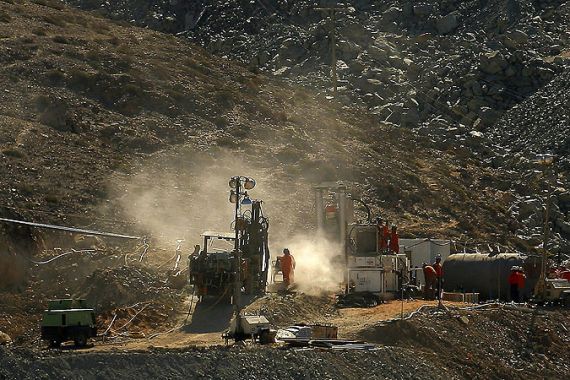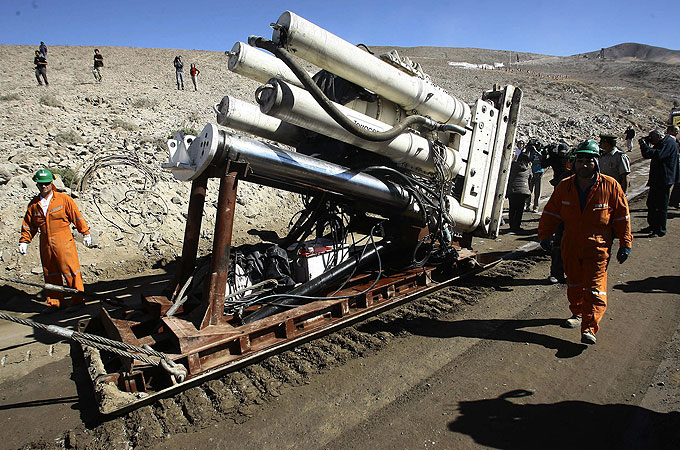Chile mine rescue drilling begins
Engineers start tunnel-boring work as rescue efforts to free 33 miners trapped underground enter second week.

 |
| Chilean officials said it might take up to four months to get the 33 men out of the mine shaft [EPA] |
Preliminary drilling works have begun to carve a tunnel through solid rock to free 33 workers trapped some 700 metres below the surface in a Chilean mine.
A giant 31-tonne drill bored about 15 metres into the rock on Monday – the first step in the week-long effort – as the miners’ ordeal equalled the longest known survival in an underground disaster.
Keep reading
list of 4 itemsAfter the Hurricane
World’s coral reefs face global bleaching crisis
Why is Germany maintaining economic ties with China?
Later the drill will be outfitted with larger bits to expand the hole and pull the men through, a process officials say could take four months.
The men were trapped on August 5 in the San Jose mine in Chile’s northern Atacama Desert.
Before rescuers dug bore holes to reach them, they survived 17 days without contact with the outside world by rationing a 48-hour supply of food and digging for water in the ground.
Only three miners who survived 25 days trapped in a flooded mine in southern China last year are known to have survived underground as long.
“The drill operators have the best equipment available internationally,” Dave Feickert, the director of KiaOra, a mine safety consulting firm in New Zealand, said.
‘Technical problems’
Feickert, who has worked extensively with China’s government to improve dangerous mines there, said it “doesn’t mean it will be easy”.
“They are likely to run into some technical problems that may slow them down,” he added.
Meanwhile, officials were pushing for an accelerated rescue plan, and Sebastian Pinera, the Chilean president, said he wanted the miners out before September 18, the bicentennial anniversary of Chile’s independence from Spanish colonial rule.
Jaime Manalich, the Chilean health minister, said another plan “has already been designed”, adding that details would be released soon.
Under the current plans, a hydraulic bore will begin drilling a hole 66cm wide aimed at pulling the miners out one at a time from the hot and damp shelter where they are huddled underground.
“The shaft we’re drilling to the shelter will go down 702m in a straight line [to the trapped miners]”, Andre Sougarret, the engineer in charge of the rescue operation, told AFP news agency on Saturday.
He said the drilling operation was expected to last three to four months, as the hydraulic bore drills at a maximum rate of 20m per day.
Wage concerns
Meanwhile, a union leader has raised concerns about the workers livelihoods after the government suspended mining company San Esteban’s operating licence.
The company has said it had no money to pay wages and absorb lawsuits.
Evelyn Olmos, a union leader, asked the government to pay the workers’ wages starting in September, and to cover the roughly 100 other people at the mine who are now jobless with 170 more who work elsewhere for San Esteban.
“We want the government to pay our salaries in full until our comrades are freed and then pay our severances,” she said.
Laurence Golborne, the Chilean mining minister, said labour laws barred the government from assuming responsibility for salaries, and that workers needed to seek redress from the company and the courts.
Tonnes of debris
The drilling is expected to cause rock to fall down into the mine shaft area near the trapped men, and failure to keep the bottom clear of debris could quickly plug the hole, delaying the rescue.
Therefore, the trapped miners will have to clear tonnes of rocks, requiring them to work in shifts all through the rescue.
Officials are also considering drilling where the main entrance ramp to the San Jose gold and silver mine collapsed, though some engineers fear the site remains unstable.
 |
| The trapped miners on Monday equalled the longest known survival in an underground disaster [AFP] |
A third option being tabled suggests broadening an already existing shaft, about 300 metres from the emergency shelter where the miners are confined.
Golborne, the mining minister, has denied reports of a possible rescue within the next month.
“We have reviewed 10 different options,” he told Radio Cooperativa. “Up to now there is no alternative … that would allow us to get them out in 30 days.”
The trapped miners spoke for the first time with their loved ones Sunday, reassuring each other in brief conversations by radio-telephone.
“To hear his voice was a balm to my heart,” Jessica Chille said after speaking to her husband, Dario Segovia.
Limited to one minute per miner, the wives, mothers and fathers lined up for their first person-to-person conversations since a cave-in on August 5 that blocked the miners’ exit from the San Jose gold and copper mine.
‘Excellent odds’
Peter McCarthy, a mining expert in Australia, said the heat and humidity in the mine could put the miners’ health at risk but said the odds of them being rescued alive were “excellent”.
“My understanding of the situation is that there’s a large space there for them,” he told Al Jazeera.
“They have hundreds of metres, if not kilometres, of tunnels they can move through and with the connection of three large bore holes down to them, air, supplies and communications can be maintained.”
While most of the miners appear to be in good spirits, a handful of them seem to be struggling psychologically.
Manalich, the Chile health minister, said five depressed miners were in a better state of mind after receiving food, vitamins and communicating with friends and relatives, who sent them a video recording earlier Saturday.
Chilean authorities have already taken steps to improve the men’s mental resilience for the wait that lays ahead, especially by reaching out to organisations and individuals with experience in long isolation.
Four officials from the US space agency Nasa were due to arrive in Chille to provide expertise, while submarine commanders in Chile’s navy have already given advice.